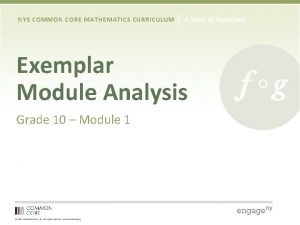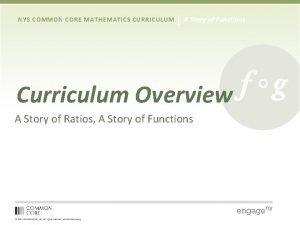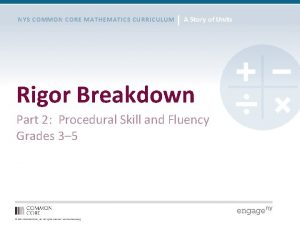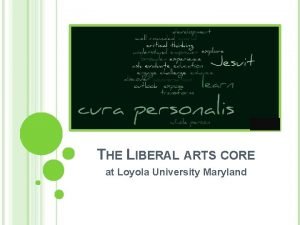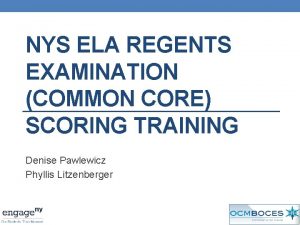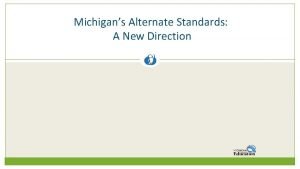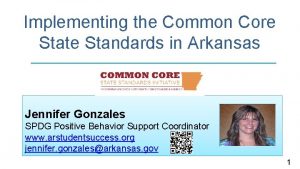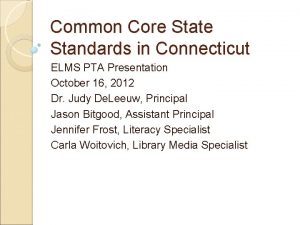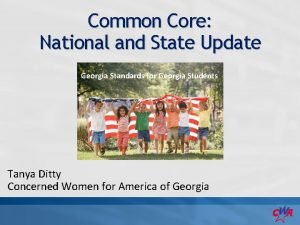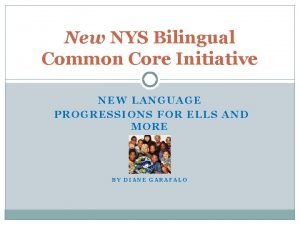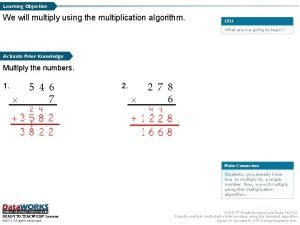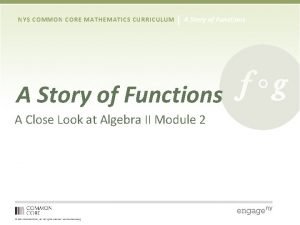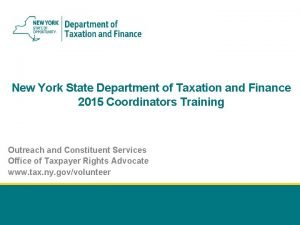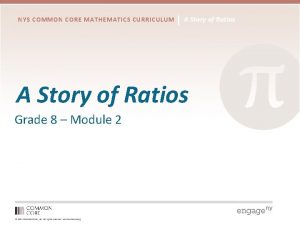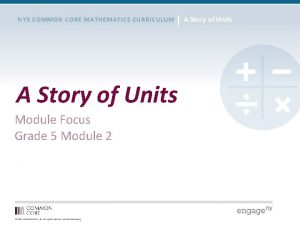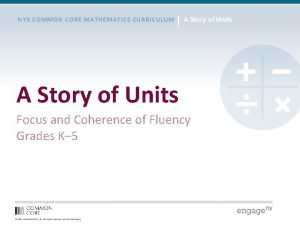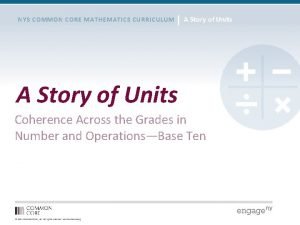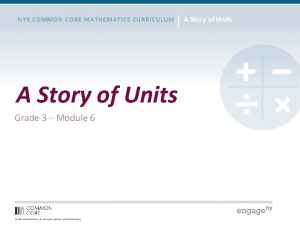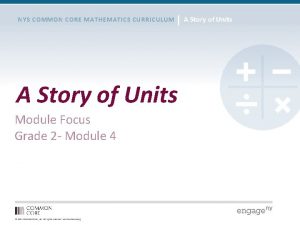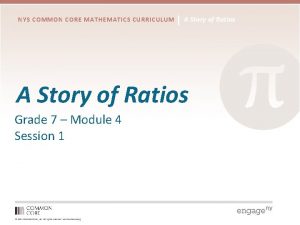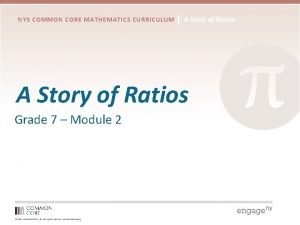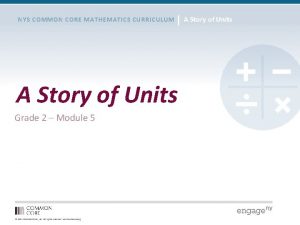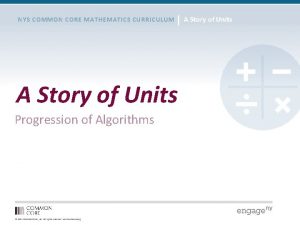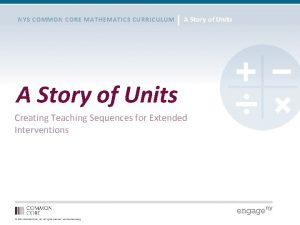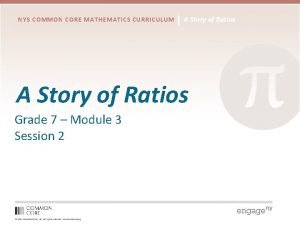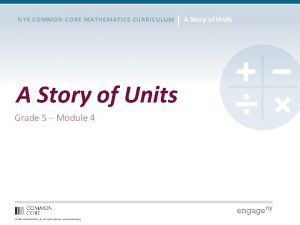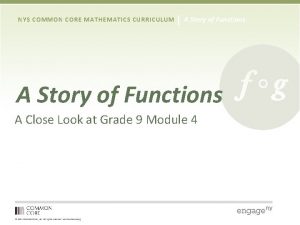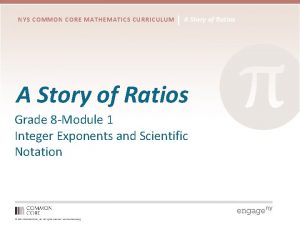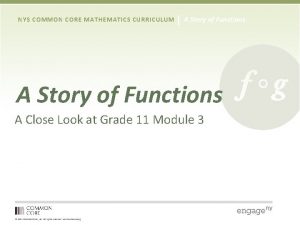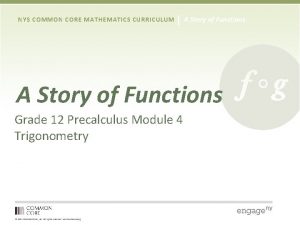NYS COMMON CORE MATHEMATICS CURRICULUM A Story of

































































- Slides: 65

NYS COMMON CORE MATHEMATICS CURRICULUM A Story of Ratios Grade 8 – Module 3 © 2012 Common Core, Inc. All rights reserved. commoncore. org

NYS COMMON CORE MATHEMATICS CURRICULUM A Story of Ratios Session Objectives • Examine the development of mathematical understanding across the module using a focus on concept development within the lessons. • Identify the big idea within each topic in order to support instructional choices that achieve the lesson objectives while maintaining rigor within the curriculum. © 2012 Common Core, Inc. All rights reserved. commoncore. org

NYS COMMON CORE MATHEMATICS CURRICULUM Agenda Introduction to the Module Concept Development Module Review © 2012 Common Core, Inc. All rights reserved. commoncore. org A Story of Ratios

NYS COMMON CORE MATHEMATICS CURRICULUM A Story of Ratios Curriculum Overview of A Story of Ratios © 2012 Common Core, Inc. All rights reserved. commoncore. org

NYS COMMON CORE MATHEMATICS CURRICULUM Agenda Introduction to the Module Concept Development Module Review © 2012 Common Core, Inc. All rights reserved. commoncore. org A Story of Ratios

NYS COMMON CORE MATHEMATICS CURRICULUM A Story of Ratios L 1: What lies behind “same shape”? • What does is mean for figures to be considered similar? Is describing them as “same shape” good enough? • Introduction to dilations • Center • Scale factor • Dilations do not preserve the lengths of segments. Rather, the length of a dilated segment is equal to the length of the original segment multiplied by the scale factor of dilation. Lesson 1, Concept Development © 2012 Common Core, Inc. All rights reserved. commoncore. org

NYS COMMON CORE MATHEMATICS CURRICULUM Exercises 2 -6 © 2012 Common Core, Inc. All rights reserved. commoncore. org A Story of Ratios

NYS COMMON CORE MATHEMATICS CURRICULUM A Story of Ratios If the scale factor is r=3, what is the length of segment OP' ? The length of the segment OP' is 9 cm. Use the definition of dilation to show that your answer to Exercise 2 is correct. |OP’|=r|OP|, therefore, |OP’|=3× 3=9 and |OP’|=9. If the scale factor is r=3, what is the length of segment OQ'? The length of the segment OQ' is 12 cm. Use the definition of dilation to show that your answer to Exercise 4 is correct. |OQ’|=r|OQ|, therefore, |OQ’|=3× 4=12 and |OQ’|=12. If you know that OP=3, OP'=9, how could you use that information to determine the scale factor? © 2012 Common Core, Inc. All rights reserved. commoncore. org

NYS COMMON CORE MATHEMATICS CURRICULUM Lesson 1, Student Debrief © 2012 Common Core, Inc. All rights reserved. commoncore. org A Story of Ratios

NYS COMMON CORE MATHEMATICS CURRICULUM L 2: Properties of Dilations • Dilations maps lines to lines, segments to segments, rays to rays, and angles to angles. • Dilations preserve the measures of angles. • Properties verified experimentally Lesson 2, Concept Development © 2012 Common Core, Inc. All rights reserved. commoncore. org A Story of Ratios

NYS COMMON CORE MATHEMATICS CURRICULUM Problem Set 1 © 2012 Common Core, Inc. All rights reserved. commoncore. org A Story of Ratios

NYS COMMON CORE MATHEMATICS CURRICULUM Problem Set 1 © 2012 Common Core, Inc. All rights reserved. commoncore. org A Story of Ratios

NYS COMMON CORE MATHEMATICS CURRICULUM Lesson 2, Student Debrief © 2012 Common Core, Inc. All rights reserved. commoncore. org A Story of Ratios

NYS COMMON CORE MATHEMATICS CURRICULUM L 3: Examples of Dilations • In the past, topics of congruence and similarity only existed in the world of rectilinear figures. Knowledge of the basic rigid motions and dilation in general provide the opportunity to explore these concepts with curvilinear shapes. • How do we return a dilated figure back to its original size? Lesson 3, Concept Development © 2012 Common Core, Inc. All rights reserved. commoncore. org A Story of Ratios

NYS COMMON CORE MATHEMATICS CURRICULUM Example 2 © 2012 Common Core, Inc. All rights reserved. commoncore. org A Story of Ratios

NYS COMMON CORE MATHEMATICS CURRICULUM Lesson 3, Student Debrief © 2012 Common Core, Inc. All rights reserved. commoncore. org A Story of Ratios

NYS COMMON CORE MATHEMATICS CURRICULUM A Story of Ratios L 4: Fundamental Theorem of Similarity (FTS) • FTS is explored in terms of dilation. Theorem: Given a dilation with center O and scale factor r, then for any two points P, Q in the plane so the O, P, Q are not collinear, the lines PQ and P’Q’ are parallel, where P’=dilation(P) and Q’=dilation (Q), and furthermore, |P'Q’|=r|PQ|. • Teacher led activity based lesson using lined paper and a ruler. Lesson 4, Concept Development © 2012 Common Core, Inc. All rights reserved. commoncore. org

NYS COMMON CORE MATHEMATICS CURRICULUM A Story of Ratios Activity • On a lined piece of paper: • Choose a point near the top of the page on a line to use as our center of dilation. Label the point O. • Draw a ray, from point O, through a whole number of lines, e. g. , through 2 lines, or 5 lines, etc. Label this point P. • Draw another ray, from point O, through the same number of lines. Label this point Q. • Along ray (you may need to extend it), find another point, P’, a whole number of lines away from O. • Along ray (you may need to extend it), find another point, Q’, the same whole number of lines away from O. • Connect points P and Q. Connect points P’ and Q’. © 2012 Common Core, Inc. All rights reserved. commoncore. org

NYS COMMON CORE MATHEMATICS CURRICULUM A Story of Ratios Activity • What do you notice about lines PQ and P’Q’? • Lines PQ and P’Q’ are parallel, i. e. , they never intersect. • Write the scale factor that represents the dilation from O to P and O to P’, e. g. , if you went 2 lines for P and 5 lines for P’, then scale factor r = 5/2. • Why does it make sense for the scale factor to be r = 5/2 and not r = 2/5? • If triangle OPQ was the original figure and it has been dilated to triangle OP’Q’ (where the lengths of the sides are longer than the original), that means that the triangle has been magnified, therefore the scale factor should be greater than 1. • Now if triangle OPQ was the original figure and it has been dilated to triangle OP’Q’ (where the lengths of the sides are shorter than the original), that means the triangle has been shrunk, therefore the scale factor should be less than one (but greater than zero). © 2012 Common Core, Inc. All rights reserved. commoncore. org

NYS COMMON CORE MATHEMATICS CURRICULUM A Story of Ratios Activity (cont. ) • Measure the distance from O to P, label your diagram. Measure and label OP’, OQ, and OQ’. • Compare the length of the dilated segment to the original: OP’ to OP, and OQ’ to OQ. (Use values rounded to nearest tenths place. ) What do you notice? • You should notice that the length of the dilated segment OP’ divided by the original segment OP is equal to OQ’ divided by OQ. © 2012 Common Core, Inc. All rights reserved. commoncore. org

NYS COMMON CORE MATHEMATICS CURRICULUM A Story of Ratios Activity (cont. ) • Measure the lengths P’Q’ and PQ. Compare the lengths as before. What do you notice? • It is also equal! • Now compare the ratio of the lengths to the scale factor. What do you notice? • In each case, the ratio of the segment lengths is equal to the scale factor. © 2012 Common Core, Inc. All rights reserved. commoncore. org

NYS COMMON CORE MATHEMATICS CURRICULUM A Story of Ratios Why does it work? • The Fundamental Theorem of Similarity: • If D is a dilation with center O and scale factor r, then for any two points P, Q in the plane so that O, P, Q are not collinear, the lines PQ and P’Q’ are parallel, where P’ = D(P), and Q’ = D(Q), and furthermore, • Mathematically speaking; Therefore, © 2012 Common Core, Inc. All rights reserved. commoncore. org

NYS COMMON CORE MATHEMATICS CURRICULUM A Story of Ratios What does it all mean? • Are triangles OPQ and OP’Q’ similar? • Use your transparency to trace angle OPQ. Translate along the vector Does angle OPQ map onto angle OP’Q’? What does that mean? • Dilations preserve the measures of angles. The triangles are similar by AA criterion. • The lengths of the sides of the triangles are in “proportion” and equal to the scale factor of dilation. • In general, two figures are said to be similar if you can map one onto another by a dilation followed by a congruence. © 2012 Common Core, Inc. All rights reserved. commoncore. org

NYS COMMON CORE MATHEMATICS CURRICULUM Lesson 4, Student Debrief © 2012 Common Core, Inc. All rights reserved. commoncore. org A Story of Ratios

NYS COMMON CORE MATHEMATICS CURRICULUM A Story of Ratios L 5: First Consequence of FTS • Converse of FTS. • Students first experience the effect dilations have on points in the coordinate plane as an application of FTS. Lesson 5, Concept Development © 2012 Common Core, Inc. All rights reserved. commoncore. org

NYS COMMON CORE MATHEMATICS CURRICULUM Exercise 3 © 2012 Common Core, Inc. All rights reserved. commoncore. org A Story of Ratios

NYS COMMON CORE MATHEMATICS CURRICULUM Lesson 5, Student Debrief © 2012 Common Core, Inc. All rights reserved. commoncore. org A Story of Ratios

NYS COMMON CORE MATHEMATICS CURRICULUM A Story of Ratios L 6: Dilations on the Coordinate Plane • Students generalize what they observed about dilations of points using FTS, that is, students recognize the multiplicative effect that dilations have on the coordinates. • Given a dilation with scale factor r and center at the origin, a point in the plane (x, y), after the dilation will be located at (rx, ry). Lesson 6, Concept Development © 2012 Common Core, Inc. All rights reserved. commoncore. org

NYS COMMON CORE MATHEMATICS CURRICULUM Example 1 © 2012 Common Core, Inc. All rights reserved. commoncore. org A Story of Ratios

NYS COMMON CORE MATHEMATICS CURRICULUM Example 1 © 2012 Common Core, Inc. All rights reserved. commoncore. org A Story of Ratios

NYS COMMON CORE MATHEMATICS CURRICULUM Lesson 6, Student Debrief © 2012 Common Core, Inc. All rights reserved. commoncore. org A Story of Ratios

NYS COMMON CORE MATHEMATICS CURRICULUM L 7: Informal Proofs of Dilations • Optional lesson. • Properties observed in Lesson 2 are proved informally. Lesson 7, Concept Development © 2012 Common Core, Inc. All rights reserved. commoncore. org A Story of Ratios

NYS COMMON CORE MATHEMATICS CURRICULUM Discussion © 2012 Common Core, Inc. All rights reserved. commoncore. org A Story of Ratios

NYS COMMON CORE MATHEMATICS CURRICULUM Lesson 7, Student Debrief © 2012 Common Core, Inc. All rights reserved. commoncore. org A Story of Ratios

NYS COMMON CORE MATHEMATICS CURRICULUM A Story of Ratios L 8: Similarity • Is dilation enough to prove that two figures are similar? • Similarity is defined as a dilation followed by a congruence. • Show figures are similar by describing the sequence of the dilation and congruence. Lesson 8, Concept Development © 2012 Common Core, Inc. All rights reserved. commoncore. org

NYS COMMON CORE MATHEMATICS CURRICULUM Exercise 1 © 2012 Common Core, Inc. All rights reserved. commoncore. org A Story of Ratios

NYS COMMON CORE MATHEMATICS CURRICULUM A Story of Ratios Exercise 1 Dilate A”B”C” by a scale factor of 2 from the origin. Then translate. © 2012 Common Core, Inc. All rights reserved. commoncore. org

NYS COMMON CORE MATHEMATICS CURRICULUM Lesson 8, Student Debrief © 2012 Common Core, Inc. All rights reserved. commoncore. org A Story of Ratios

NYS COMMON CORE MATHEMATICS CURRICULUM L 9: Basic Properties of Similarity • Similarity is symmetric. If triangle A is similar to triangle B, then triangle B is similar to triangle A. • Similarity is transitive. If triangle A is similar to triangle B, and triangle B is similar to triangle C, then triangle A is similar to triangle C. Lesson 9, Concept Development © 2012 Common Core, Inc. All rights reserved. commoncore. org A Story of Ratios

NYS COMMON CORE MATHEMATICS CURRICULUM Exploratory Challenge 2 © 2012 Common Core, Inc. All rights reserved. commoncore. org A Story of Ratios

NYS COMMON CORE MATHEMATICS CURRICULUM Lesson 9, Student Debrief © 2012 Common Core, Inc. All rights reserved. commoncore. org A Story of Ratios

NYS COMMON CORE MATHEMATICS CURRICULUM A Story of Ratios L 10: Informal Proof of the AA Criterion for Similarity • Straightforward proof, then a direct application using the triangle sum theorem from Module 2. • Students practice presenting informal arguments to show that two triangles are similar. Lesson 10, Concept Development © 2012 Common Core, Inc. All rights reserved. commoncore. org

NYS COMMON CORE MATHEMATICS CURRICULUM Exercise 4 © 2012 Common Core, Inc. All rights reserved. commoncore. org A Story of Ratios

NYS COMMON CORE MATHEMATICS CURRICULUM Exercise 5 © 2012 Common Core, Inc. All rights reserved. commoncore. org A Story of Ratios

NYS COMMON CORE MATHEMATICS CURRICULUM Lesson 10, Student Debrief © 2012 Common Core, Inc. All rights reserved. commoncore. org A Story of Ratios

NYS COMMON CORE MATHEMATICS CURRICULUM A Story of Ratios L 11: More About Similar Triangles • Find the length of a segment of a triangle • Verify that triangles are similar • Write ratios of corresponding sides. They are equivalent fractions, why? • Find the number that makes the fractions equal. Lesson 11, Concept Development © 2012 Common Core, Inc. All rights reserved. commoncore. org

NYS COMMON CORE MATHEMATICS CURRICULUM Exercise 1 © 2012 Common Core, Inc. All rights reserved. commoncore. org A Story of Ratios

NYS COMMON CORE MATHEMATICS CURRICULUM A Story of Ratios Exercise 1 Based on the information given, is △ABC~△AB'C'? Explain. There is not enough information provided to determine if the triangles are similar. We would need information about a pair of corresponding angles or more information about the side lengths of each of the triangles. Assume line BC is parallel to line B'C'. With this information, can you say that △ABC~△AB'C'? Explain. If line BC is parallel to line B'C', then △ABC~△AB'C'. Both triangles share ∠A. Another pair of equal angles is ∠AB'C'and ∠ABC. They are equal because they are corresponding angles of parallel lines. By the AA criterion, △ABC~△AB'C'. Given that △ABC~△AB'C', determine the length of AC'. Let x represent the length of AC'. x/6=2/8 We are looking for the value of x that makes the fractions equivalent. Therefore 8 x=12, and x=1. 5. The length of AC' is 1. 5. © 2012 Common Core, Inc. All rights reserved. commoncore. org

NYS COMMON CORE MATHEMATICS CURRICULUM Lesson 11, Student Debrief © 2012 Common Core, Inc. All rights reserved. commoncore. org A Story of Ratios

NYS COMMON CORE MATHEMATICS CURRICULUM A Story of Ratios L 12: Modeling Using Similarity • Knowledge of similarity leads to ability to take an indirect measurement of • • distance across a lake. length of wood needed for a skate ramp. height of a building. height of a tree. Lesson 12, Concept Development © 2012 Common Core, Inc. All rights reserved. commoncore. org

NYS COMMON CORE MATHEMATICS CURRICULUM Exercise 1 © 2012 Common Core, Inc. All rights reserved. commoncore. org A Story of Ratios

NYS COMMON CORE MATHEMATICS CURRICULUM Lesson 12, Student Debrief © 2012 Common Core, Inc. All rights reserved. commoncore. org A Story of Ratios

NYS COMMON CORE MATHEMATICS CURRICULUM A Story of Ratios L 13: Proof of the Pythagorean Theorem • Proof of Pythagorean theorem using similar triangles. • Traditional application of Pythagorean theorem to find lengths of right triangles. Lesson 13, Concept Development © 2012 Common Core, Inc. All rights reserved. commoncore. org

NYS COMMON CORE MATHEMATICS CURRICULUM Proof © 2012 Common Core, Inc. All rights reserved. commoncore. org A Story of Ratios

NYS COMMON CORE MATHEMATICS CURRICULUM © 2012 Common Core, Inc. All rights reserved. commoncore. org A Story of Ratios

NYS COMMON CORE MATHEMATICS CURRICULUM © 2012 Common Core, Inc. All rights reserved. commoncore. org A Story of Ratios

NYS COMMON CORE MATHEMATICS CURRICULUM © 2012 Common Core, Inc. All rights reserved. commoncore. org A Story of Ratios

NYS COMMON CORE MATHEMATICS CURRICULUM Lesson 13, Student Debrief © 2012 Common Core, Inc. All rights reserved. commoncore. org A Story of Ratios

NYS COMMON CORE MATHEMATICS CURRICULUM A Story of Ratios L 14: The Converse of the Pythagorean Theorem • Proof of the converse of Pythagorean theorem. Given three lengths that satisfy the Pythagorean theorem, the lengths form a right triangle. • Students give informal proofs about right triangles using the Pythagorean theorem. Lesson 14, Concept Development © 2012 Common Core, Inc. All rights reserved. commoncore. org

NYS COMMON CORE MATHEMATICS CURRICULUM Proof © 2012 Common Core, Inc. All rights reserved. commoncore. org A Story of Ratios

NYS COMMON CORE MATHEMATICS CURRICULUM © 2012 Common Core, Inc. All rights reserved. commoncore. org A Story of Ratios

NYS COMMON CORE MATHEMATICS CURRICULUM Lesson 1, Student Debrief © 2012 Common Core, Inc. All rights reserved. commoncore. org A Story of Ratios

NYS COMMON CORE MATHEMATICS CURRICULUM Agenda Introduction to the Module Concept Development Module Review © 2012 Common Core, Inc. All rights reserved. commoncore. org A Story of Ratios

NYS COMMON CORE MATHEMATICS CURRICULUM Biggest Takeaway Turn and Talk: • What questions were answered for you? • What new questions have surfaced? © 2012 Common Core, Inc. All rights reserved. commoncore. org A Story of Ratios

NYS COMMON CORE MATHEMATICS CURRICULUM A Story of Ratios Key Points • • Dilation leads to an understanding of similarity. Dilations begin off the coordinate plane, then become fixed to examine the effect dilations and rigid motions have on coordinates. © 2012 Common Core, Inc. All rights reserved. commoncore. org
 Nys common core
Nys common core Nys common core mathematics curriculum
Nys common core mathematics curriculum Nys common core mathematics curriculum
Nys common core mathematics curriculum The brittle, rocky outer layer of earth
The brittle, rocky outer layer of earth Earth crust thickness
Earth crust thickness Layers of earth from most dense to least dense
Layers of earth from most dense to least dense Core rigidity
Core rigidity Sas core requirements
Sas core requirements Loyola maryland core curriculum
Loyola maryland core curriculum Chinese national curriculum core subjects
Chinese national curriculum core subjects National curriculum core subjects
National curriculum core subjects Loyola maryland core requirements
Loyola maryland core requirements Ota core curriculum
Ota core curriculum Iowa core curriculum
Iowa core curriculum Positioning statement
Positioning statement Ncgia core curriculum
Ncgia core curriculum Kidney biopsy core curriculum
Kidney biopsy core curriculum National core curriculum for basic education 2014
National core curriculum for basic education 2014 Loyola md core requirements
Loyola md core requirements Ung core plan of study
Ung core plan of study What is core curriculum
What is core curriculum Maerb
Maerb Occt oklahoma
Occt oklahoma Pab ankle fracture
Pab ankle fracture Unpacking common core standards
Unpacking common core standards Essential elements standards
Essential elements standards Ela regents part 3 rubric
Ela regents part 3 rubric Common core essential elements michigan
Common core essential elements michigan Common core standards arkansas
Common core standards arkansas Fraction quantity relative to whole
Fraction quantity relative to whole Unpacking standards worksheet
Unpacking standards worksheet Connecticut common core state standards
Connecticut common core state standards Georgia common core standards
Georgia common core standards Common core institute
Common core institute Utah core math standards
Utah core math standards 4th grade math jeopardy common core
4th grade math jeopardy common core Bilingual common core standards
Bilingual common core standards Common core lattice multiplication
Common core lattice multiplication Common core state standards missouri
Common core state standards missouri Ksde social studies standards
Ksde social studies standards Lesson 4 from circle-ometry to trigonometry
Lesson 4 from circle-ometry to trigonometry Common core standards kentucky
Common core standards kentucky Common core ela assessments
Common core ela assessments Common career technical core standards
Common career technical core standards Factors of 18
Factors of 18 Common anode and common cathode
Common anode and common cathode Factor tree of 56
Factor tree of 56 Factors of 54
Factors of 54 What is the least common multiple of 18 and 27
What is the least common multiple of 18 and 27 Highest common factors and lowest common multiples
Highest common factors and lowest common multiples God's big story curriculum
God's big story curriculum Iowa social studies standards unpacked
Iowa social studies standards unpacked Nycte
Nycte The beaks of finches, student laboratory packet
The beaks of finches, student laboratory packet Nys omh pmcs training
Nys omh pmcs training Relationships and biodiversity lab answers
Relationships and biodiversity lab answers Earth science lab practical review
Earth science lab practical review Ogs design and construction
Ogs design and construction Dmv compass
Dmv compass Nysdecals
Nysdecals Community development program
Community development program Engage ny.org
Engage ny.org Nys ela 2015
Nys ela 2015 Nytprin exclusion code
Nytprin exclusion code Nys cdos standards
Nys cdos standards Maria nys
Maria nys
